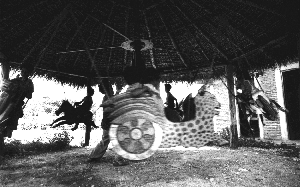Dentzel Carousel Family History
The Dentzel Carousel Company expresses itself today
through 5th generation carouselmaker William H. Dentzel, headquartered
in Port Townsend, Washington on the North Olympic Peninsula of the USA.
The tradition began in early an 1800's southern
German wagonmakers shop. Dentzel carousels became larger over time;
mid-19th century
second-generation Dentzel carouselmaaking brothers sailed cross the
Atlantic in several waves with carousel parts to assemble and test the
American market. Carousels became larger, more
elaborate, and widespread during the turn-of-the-century era. Third
generation Dentzel carouselmakers saw the collapse of the industry
during the great depression at which time more practical home building
became the family trade. Fourth generation carouselmaker, William H.
Dentzel 2, revived the family business in the 1960's and made small
children's carousels. Fifth generation carouselmaker, William H.
Dentzel 3, continues making 20' diameter, 15 rider traditional
wooden "flying horses" carousels for communities, they carry children
as well as adults. He also makes other animated rides and furniture.
During the early 1800's the Dentzel Carousel Company, not yet so named,
began as a winter occupation at Michael Dentzel's southern German
wagonmaking workshop. During the summer months Michael and family would
set up their carousel on village sites as they traveled by horse drawn
wagons throughout southern Germany.
Michael sent his sons across the Atlantic Ocean to the United States in the 1850's and 1860's.
Gustav, the was in charge carousel parts packed on
the sailing steamer to America around 1860. In Philadelphia,
Pennsylvania Gustav established a cabinetmaking and carouselmaking
business, by 1867 the carousel business began to flourish. Many trained European
immigrant woodworkers were hired by the Dentzel company to make the
beautiful horses and menagerie animals as well as chariots and
remarkably sturdy mechanisms (completely covered with scenic panels and
classic wood carvings) for the Dentzel Carousel Company of Germantown,
Pennsylvania. These were set up in large pavilions in cities across the
USA.
Gustav's two sons, William and Edward, continued this business building
large elegant galloping carousels, many of which continue to operate
today (see census).
Edward relocated to southern California in the 1920's to set-up and
operate carousels on amusement piers. In 1928,
with William's death, the company folded, much of its inventory was
sold to the Philadelphia Toboggan Company. Edward continued his life in
California as a house contractor in Beverly Hills building many
beautiful homes; eventually became a city councilman and then mayor.
Edward's son William 2nd, named after his uncle, was born in Santa
Monica, California, in 1921, studied at Georgetown University and
practiced law
and raised a family in the San Fernando Valley, northwest of downtown
Los Angeles. In mid-life he too answered the carouselmaker's call to
carve animals and made several small carousels for children's hospitals
and community centers (still in operation today). WHD2 passed away in
1991.
After graduating university his son William 3rd worked on wooden
sailboats and carousel restoration during travels in his 20's
eventually building his first full carousel in Chiapas, Mexico at age
31. After some more boat work and a wood carving stay in Saint
Jean-Port Joli, Québec, Canada, he moved to Port Townsend WA where he
and his wife Penny raised three children while immersed in the small
town and carousel world. Upon William 2nd's death in 1991 in Santa
Barbara CA, William 3rd continued the daunting task of fitting the
Dentzel Carousel Company into the age of computer technology and
eventually the Internet.
Community and student participation with a big focus on what the
children really enjoyed became the theme of the reinvigorated Dentzel
Carousel Company. Simple 5, 10, or 15 rider wooden carousels with
hand-crank, foot-pedal or electric powered mechanisms have become the
style that carries the craft into the 21st century. The brass ring
catching game, an integral part of the carousel ride going all the way
back to its origin over 1000 years ago, remains a standard component of
the new Dentzel Carousels.
The ancient origin of the carousel and its use as a military training
device in the early Middle Ages is where the tradition of the ring
catcher began with swords and target dummies then switched to rings as
it came into public use. The fun and versatility of the centuries old
"flying horses" style of mechanism has also been retained by the DCC.
In the Dentzel tradition a variety of menagerie animals are made for
the rides, swing seats are also used along with the animals to the
great satisfaction of the riders. Adults as well as children can ride
these latest Dentzel carousels.
This website has information and photos on the present and past
endeavors of the five generations of Dentzel carouselmakers, see the
Projects and Galleries. Also included are guides to carving, painting
and operating carousels. The coloring book on this site was drawn by
William 3rd for use as a painting guide when doing restoration work as
well as a design guide for making larger scale drawings to construct
full sized carousel animals. During the nearly two centuries of Dentzel
carouselmaking, mechanism designs have gone from the very simple to the
grand and back again to the simple. Children's attraction and
appreciation for all types of carousels has never waned though it
appears that their more intimate contact with the smaller machines is
exceptionally memorable, especially when the ring catching game is
played.
Five (maybe 6) Dentzel Carousel Making Generations:
One - Michael Dentzel, Bad Kreutznach, Germany 1809-1869 (Gustav's father)
Two - Gustav A. Dentzel, Germany-USA 1846-1909 (William 1 and Edward's father)
Three - William H. Dentzel 1, Pennsylvania 1876-1928 (no children)
Three - Edward P. Dentzel, Pennsylvania 1881-1963 (Willam 2's father)
Four - William H. Dentzel 2, Los Angeles, Caloifornia 1921-1991 (William 3's father)
Five - William H. Dentzel 3. Burbank, California 1949 (last Dentzel carouselmaker)
Six - Zaryn, Sophia, Noah Dentzel, Santa Barbara, California 1983, Port Townsend, Washington 1985, 1988.
